HSBC Bank: Non-Monetary Benefits and Employee Performance Analysis
VerifiedAdded on 2020/01/21
|19
|6009
|28
Report
AI Summary
This research proposal and subsequent report aims to analyze the impact of non-monetary benefits on employee performance, using HSBC bank as a case study. The introduction highlights the growing importance of employee motivation and strategic human resource management in the financial industry. It emphasizes the significance of both monetary and non-monetary incentives, with a focus on the latter. The research includes a literature review covering employee motivation theories like Maslow's Hierarchy of Needs, ERG theory, and Herzberg's two-factor theory. It explores the differences between monetary and non-monetary rewards, emphasizing the increasing importance of non-financial incentives. The study poses research questions regarding the types of non-monetary incentives used by HSBC, their impact on employee performance, the role of job satisfaction, and potential improvements. The objectives include evaluating theoretical perspectives, examining different types of non-monetary benefits, investigating their impact on higher-level employees, and recommending effective measures. The methodology section outlines the approach to be used, while the ethical considerations and expected research outcomes are also discussed. Finally, a timeline and Gantt chart are included to illustrate the project's progress.

RESEACH PROPOSAL
1
1
Paraphrase This Document
Need a fresh take? Get an instant paraphrase of this document with our AI Paraphraser
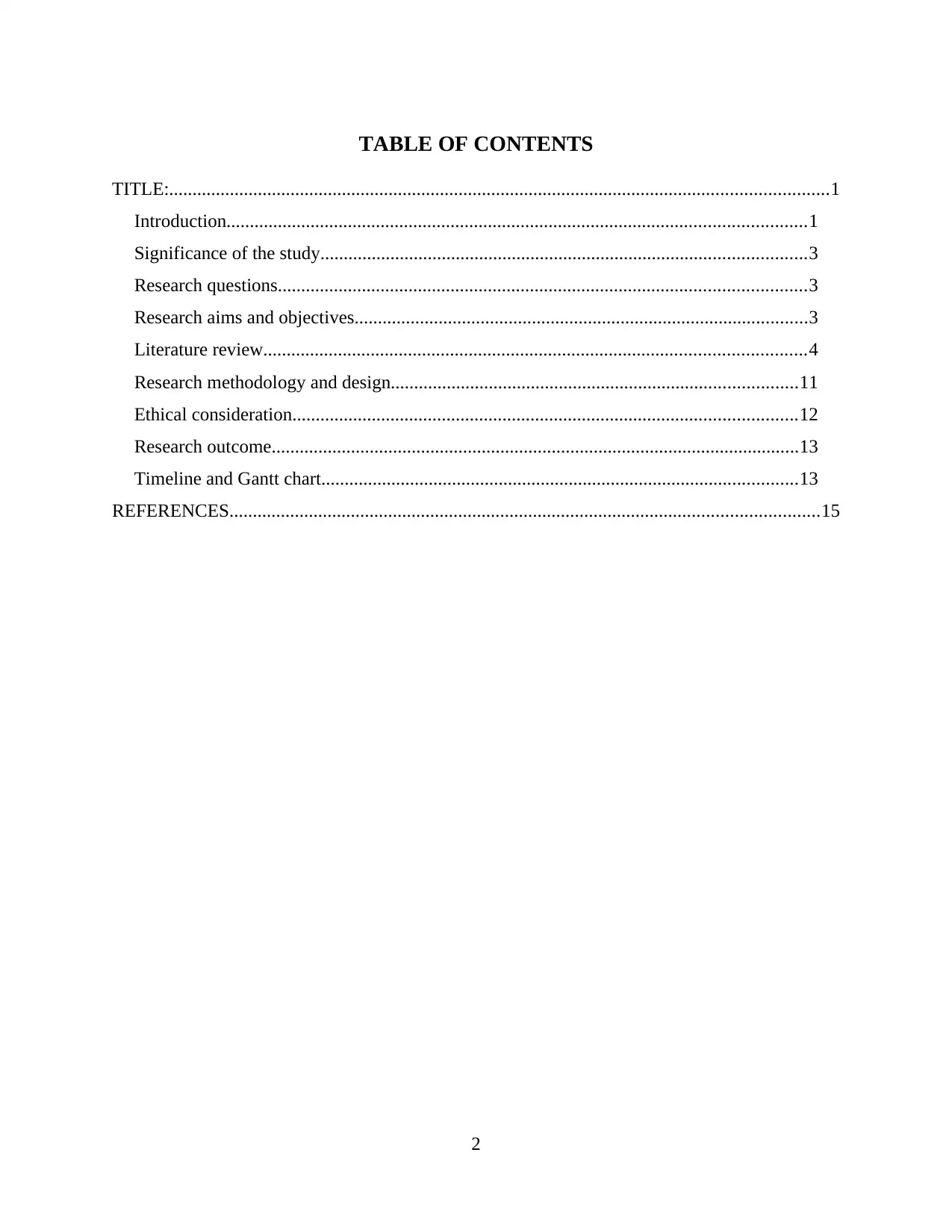
TABLE OF CONTENTS
TITLE:.............................................................................................................................................1
Introduction............................................................................................................................1
Significance of the study........................................................................................................3
Research questions.................................................................................................................3
Research aims and objectives.................................................................................................3
Literature review....................................................................................................................4
Research methodology and design.......................................................................................11
Ethical consideration............................................................................................................12
Research outcome.................................................................................................................13
Timeline and Gantt chart......................................................................................................13
REFERENCES..............................................................................................................................15
2
TITLE:.............................................................................................................................................1
Introduction............................................................................................................................1
Significance of the study........................................................................................................3
Research questions.................................................................................................................3
Research aims and objectives.................................................................................................3
Literature review....................................................................................................................4
Research methodology and design.......................................................................................11
Ethical consideration............................................................................................................12
Research outcome.................................................................................................................13
Timeline and Gantt chart......................................................................................................13
REFERENCES..............................................................................................................................15
2
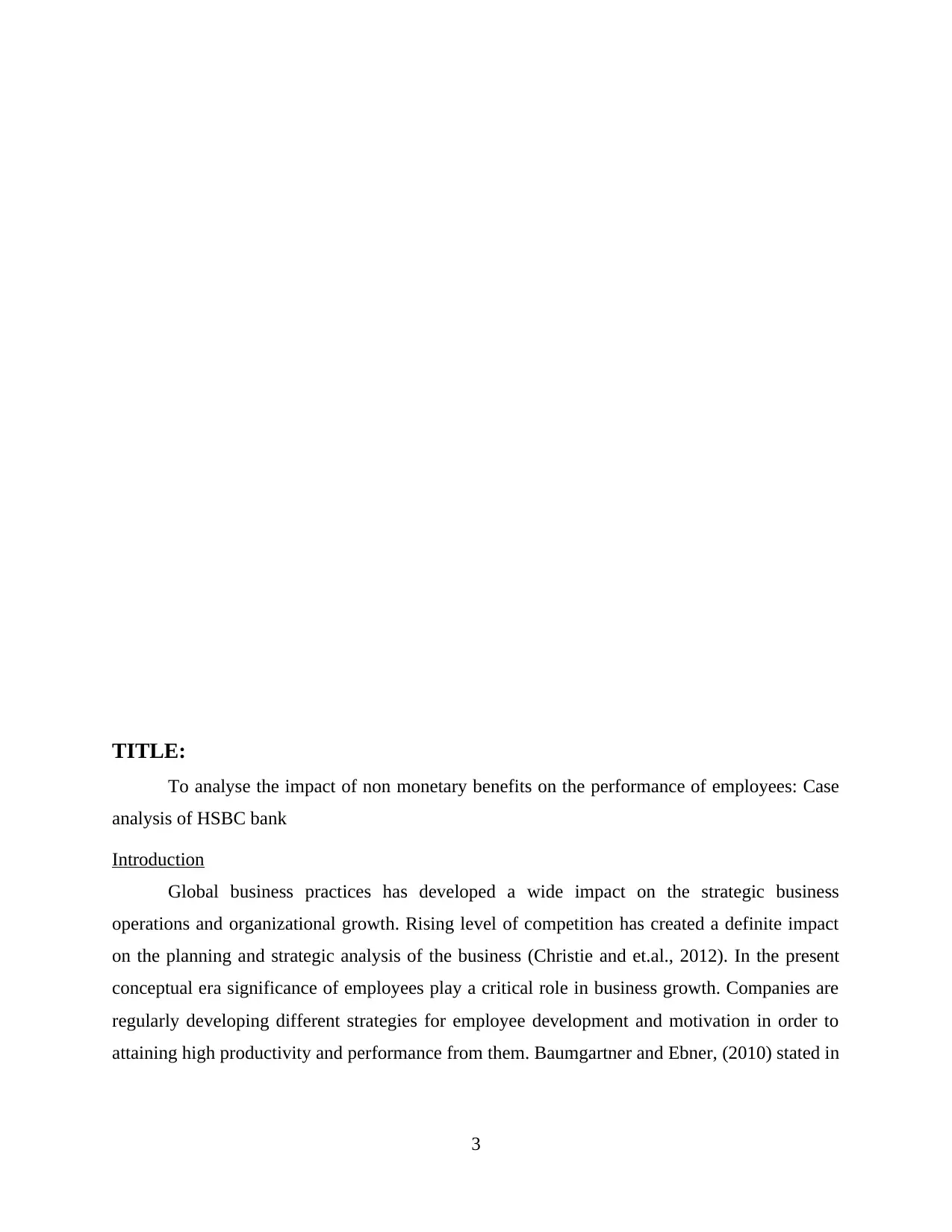
TITLE:
To analyse the impact of non monetary benefits on the performance of employees: Case
analysis of HSBC bank
Introduction
Global business practices has developed a wide impact on the strategic business
operations and organizational growth. Rising level of competition has created a definite impact
on the planning and strategic analysis of the business (Christie and et.al., 2012). In the present
conceptual era significance of employees play a critical role in business growth. Companies are
regularly developing different strategies for employee development and motivation in order to
attaining high productivity and performance from them. Baumgartner and Ebner, (2010) stated in
3
To analyse the impact of non monetary benefits on the performance of employees: Case
analysis of HSBC bank
Introduction
Global business practices has developed a wide impact on the strategic business
operations and organizational growth. Rising level of competition has created a definite impact
on the planning and strategic analysis of the business (Christie and et.al., 2012). In the present
conceptual era significance of employees play a critical role in business growth. Companies are
regularly developing different strategies for employee development and motivation in order to
attaining high productivity and performance from them. Baumgartner and Ebner, (2010) stated in
3
⊘ This is a preview!⊘
Do you want full access?
Subscribe today to unlock all pages.

Trusted by 1+ million students worldwide
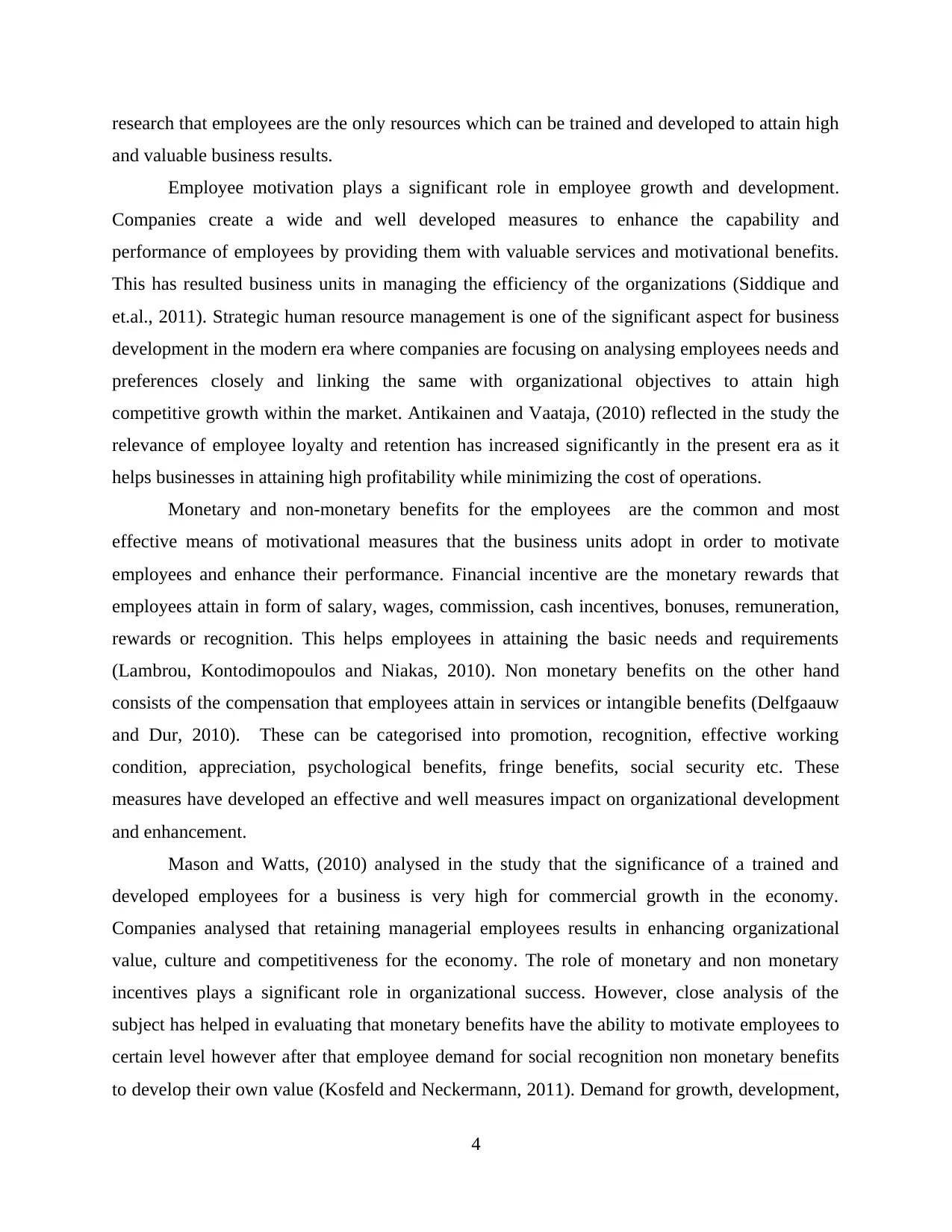
research that employees are the only resources which can be trained and developed to attain high
and valuable business results.
Employee motivation plays a significant role in employee growth and development.
Companies create a wide and well developed measures to enhance the capability and
performance of employees by providing them with valuable services and motivational benefits.
This has resulted business units in managing the efficiency of the organizations (Siddique and
et.al., 2011). Strategic human resource management is one of the significant aspect for business
development in the modern era where companies are focusing on analysing employees needs and
preferences closely and linking the same with organizational objectives to attain high
competitive growth within the market. Antikainen and Vaataja, (2010) reflected in the study the
relevance of employee loyalty and retention has increased significantly in the present era as it
helps businesses in attaining high profitability while minimizing the cost of operations.
Monetary and non-monetary benefits for the employees are the common and most
effective means of motivational measures that the business units adopt in order to motivate
employees and enhance their performance. Financial incentive are the monetary rewards that
employees attain in form of salary, wages, commission, cash incentives, bonuses, remuneration,
rewards or recognition. This helps employees in attaining the basic needs and requirements
(Lambrou, Kontodimopoulos and Niakas, 2010). Non monetary benefits on the other hand
consists of the compensation that employees attain in services or intangible benefits (Delfgaauw
and Dur, 2010). These can be categorised into promotion, recognition, effective working
condition, appreciation, psychological benefits, fringe benefits, social security etc. These
measures have developed an effective and well measures impact on organizational development
and enhancement.
Mason and Watts, (2010) analysed in the study that the significance of a trained and
developed employees for a business is very high for commercial growth in the economy.
Companies analysed that retaining managerial employees results in enhancing organizational
value, culture and competitiveness for the economy. The role of monetary and non monetary
incentives plays a significant role in organizational success. However, close analysis of the
subject has helped in evaluating that monetary benefits have the ability to motivate employees to
certain level however after that employee demand for social recognition non monetary benefits
to develop their own value (Kosfeld and Neckermann, 2011). Demand for growth, development,
4
and valuable business results.
Employee motivation plays a significant role in employee growth and development.
Companies create a wide and well developed measures to enhance the capability and
performance of employees by providing them with valuable services and motivational benefits.
This has resulted business units in managing the efficiency of the organizations (Siddique and
et.al., 2011). Strategic human resource management is one of the significant aspect for business
development in the modern era where companies are focusing on analysing employees needs and
preferences closely and linking the same with organizational objectives to attain high
competitive growth within the market. Antikainen and Vaataja, (2010) reflected in the study the
relevance of employee loyalty and retention has increased significantly in the present era as it
helps businesses in attaining high profitability while minimizing the cost of operations.
Monetary and non-monetary benefits for the employees are the common and most
effective means of motivational measures that the business units adopt in order to motivate
employees and enhance their performance. Financial incentive are the monetary rewards that
employees attain in form of salary, wages, commission, cash incentives, bonuses, remuneration,
rewards or recognition. This helps employees in attaining the basic needs and requirements
(Lambrou, Kontodimopoulos and Niakas, 2010). Non monetary benefits on the other hand
consists of the compensation that employees attain in services or intangible benefits (Delfgaauw
and Dur, 2010). These can be categorised into promotion, recognition, effective working
condition, appreciation, psychological benefits, fringe benefits, social security etc. These
measures have developed an effective and well measures impact on organizational development
and enhancement.
Mason and Watts, (2010) analysed in the study that the significance of a trained and
developed employees for a business is very high for commercial growth in the economy.
Companies analysed that retaining managerial employees results in enhancing organizational
value, culture and competitiveness for the economy. The role of monetary and non monetary
incentives plays a significant role in organizational success. However, close analysis of the
subject has helped in evaluating that monetary benefits have the ability to motivate employees to
certain level however after that employee demand for social recognition non monetary benefits
to develop their own value (Kosfeld and Neckermann, 2011). Demand for growth, development,
4
Paraphrase This Document
Need a fresh take? Get an instant paraphrase of this document with our AI Paraphraser
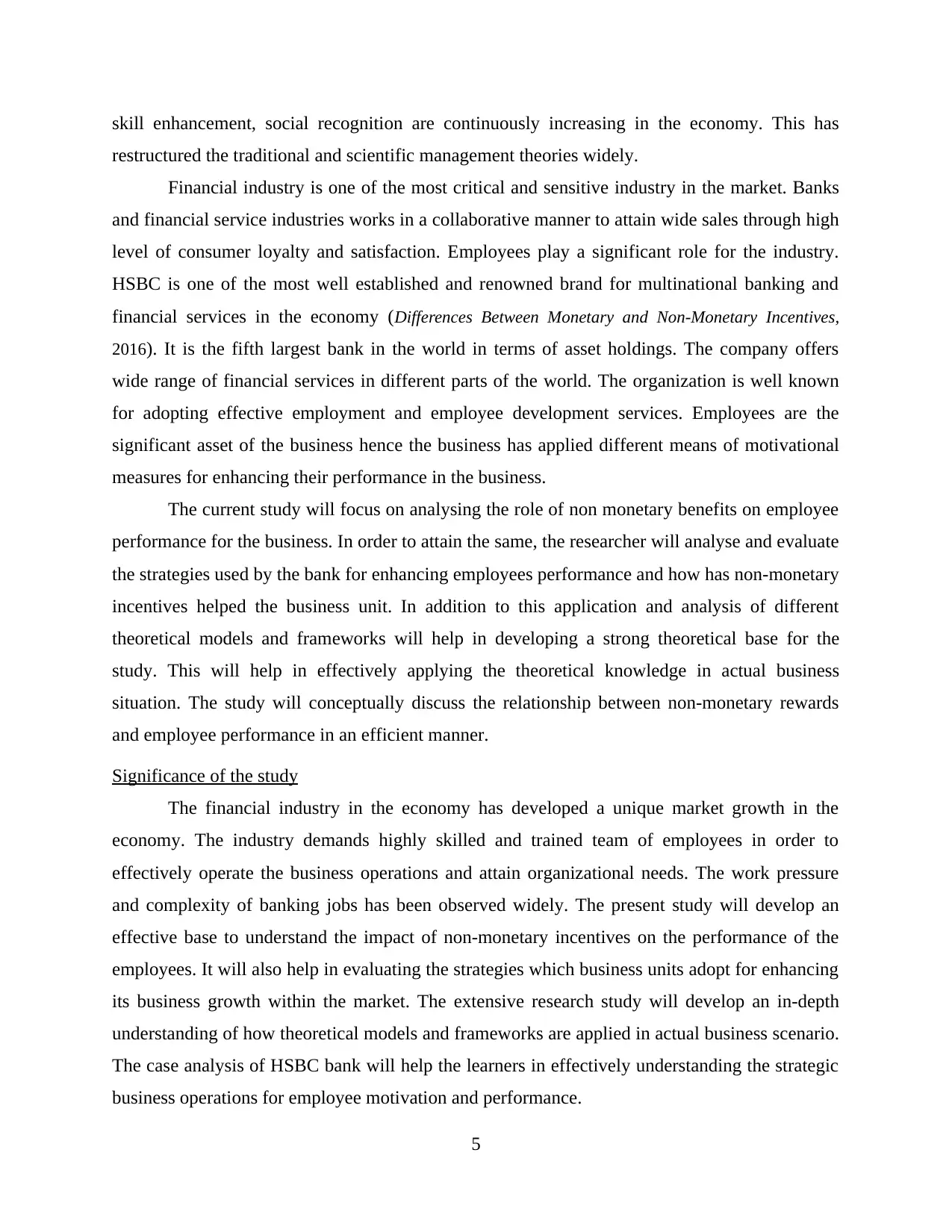
skill enhancement, social recognition are continuously increasing in the economy. This has
restructured the traditional and scientific management theories widely.
Financial industry is one of the most critical and sensitive industry in the market. Banks
and financial service industries works in a collaborative manner to attain wide sales through high
level of consumer loyalty and satisfaction. Employees play a significant role for the industry.
HSBC is one of the most well established and renowned brand for multinational banking and
financial services in the economy (Differences Between Monetary and Non-Monetary Incentives,
2016). It is the fifth largest bank in the world in terms of asset holdings. The company offers
wide range of financial services in different parts of the world. The organization is well known
for adopting effective employment and employee development services. Employees are the
significant asset of the business hence the business has applied different means of motivational
measures for enhancing their performance in the business.
The current study will focus on analysing the role of non monetary benefits on employee
performance for the business. In order to attain the same, the researcher will analyse and evaluate
the strategies used by the bank for enhancing employees performance and how has non-monetary
incentives helped the business unit. In addition to this application and analysis of different
theoretical models and frameworks will help in developing a strong theoretical base for the
study. This will help in effectively applying the theoretical knowledge in actual business
situation. The study will conceptually discuss the relationship between non-monetary rewards
and employee performance in an efficient manner.
Significance of the study
The financial industry in the economy has developed a unique market growth in the
economy. The industry demands highly skilled and trained team of employees in order to
effectively operate the business operations and attain organizational needs. The work pressure
and complexity of banking jobs has been observed widely. The present study will develop an
effective base to understand the impact of non-monetary incentives on the performance of the
employees. It will also help in evaluating the strategies which business units adopt for enhancing
its business growth within the market. The extensive research study will develop an in-depth
understanding of how theoretical models and frameworks are applied in actual business scenario.
The case analysis of HSBC bank will help the learners in effectively understanding the strategic
business operations for employee motivation and performance.
5
restructured the traditional and scientific management theories widely.
Financial industry is one of the most critical and sensitive industry in the market. Banks
and financial service industries works in a collaborative manner to attain wide sales through high
level of consumer loyalty and satisfaction. Employees play a significant role for the industry.
HSBC is one of the most well established and renowned brand for multinational banking and
financial services in the economy (Differences Between Monetary and Non-Monetary Incentives,
2016). It is the fifth largest bank in the world in terms of asset holdings. The company offers
wide range of financial services in different parts of the world. The organization is well known
for adopting effective employment and employee development services. Employees are the
significant asset of the business hence the business has applied different means of motivational
measures for enhancing their performance in the business.
The current study will focus on analysing the role of non monetary benefits on employee
performance for the business. In order to attain the same, the researcher will analyse and evaluate
the strategies used by the bank for enhancing employees performance and how has non-monetary
incentives helped the business unit. In addition to this application and analysis of different
theoretical models and frameworks will help in developing a strong theoretical base for the
study. This will help in effectively applying the theoretical knowledge in actual business
situation. The study will conceptually discuss the relationship between non-monetary rewards
and employee performance in an efficient manner.
Significance of the study
The financial industry in the economy has developed a unique market growth in the
economy. The industry demands highly skilled and trained team of employees in order to
effectively operate the business operations and attain organizational needs. The work pressure
and complexity of banking jobs has been observed widely. The present study will develop an
effective base to understand the impact of non-monetary incentives on the performance of the
employees. It will also help in evaluating the strategies which business units adopt for enhancing
its business growth within the market. The extensive research study will develop an in-depth
understanding of how theoretical models and frameworks are applied in actual business scenario.
The case analysis of HSBC bank will help the learners in effectively understanding the strategic
business operations for employee motivation and performance.
5
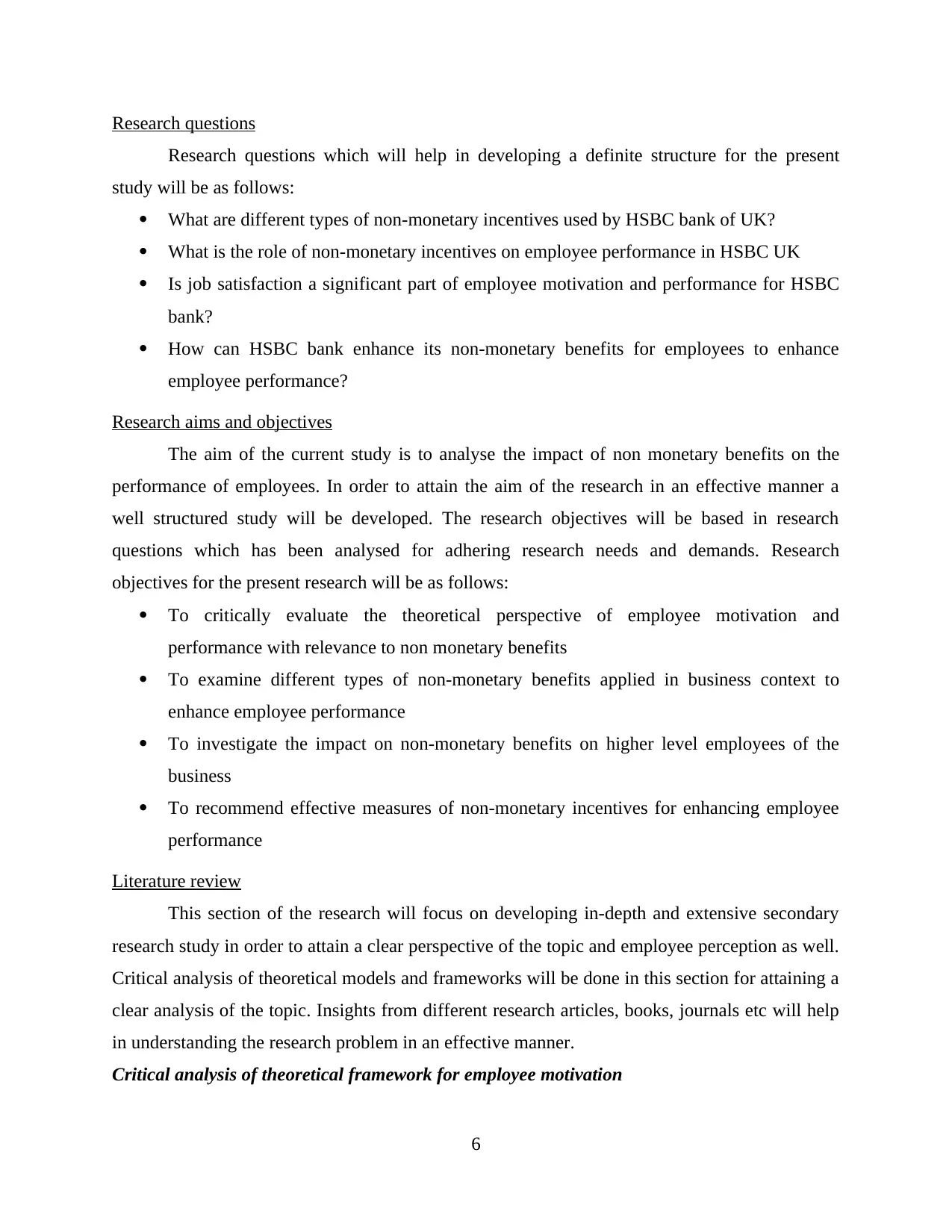
Research questions
Research questions which will help in developing a definite structure for the present
study will be as follows:
What are different types of non-monetary incentives used by HSBC bank of UK?
What is the role of non-monetary incentives on employee performance in HSBC UK
Is job satisfaction a significant part of employee motivation and performance for HSBC
bank?
How can HSBC bank enhance its non-monetary benefits for employees to enhance
employee performance?
Research aims and objectives
The aim of the current study is to analyse the impact of non monetary benefits on the
performance of employees. In order to attain the aim of the research in an effective manner a
well structured study will be developed. The research objectives will be based in research
questions which has been analysed for adhering research needs and demands. Research
objectives for the present research will be as follows:
To critically evaluate the theoretical perspective of employee motivation and
performance with relevance to non monetary benefits
To examine different types of non-monetary benefits applied in business context to
enhance employee performance
To investigate the impact on non-monetary benefits on higher level employees of the
business
To recommend effective measures of non-monetary incentives for enhancing employee
performance
Literature review
This section of the research will focus on developing in-depth and extensive secondary
research study in order to attain a clear perspective of the topic and employee perception as well.
Critical analysis of theoretical models and frameworks will be done in this section for attaining a
clear analysis of the topic. Insights from different research articles, books, journals etc will help
in understanding the research problem in an effective manner.
Critical analysis of theoretical framework for employee motivation
6
Research questions which will help in developing a definite structure for the present
study will be as follows:
What are different types of non-monetary incentives used by HSBC bank of UK?
What is the role of non-monetary incentives on employee performance in HSBC UK
Is job satisfaction a significant part of employee motivation and performance for HSBC
bank?
How can HSBC bank enhance its non-monetary benefits for employees to enhance
employee performance?
Research aims and objectives
The aim of the current study is to analyse the impact of non monetary benefits on the
performance of employees. In order to attain the aim of the research in an effective manner a
well structured study will be developed. The research objectives will be based in research
questions which has been analysed for adhering research needs and demands. Research
objectives for the present research will be as follows:
To critically evaluate the theoretical perspective of employee motivation and
performance with relevance to non monetary benefits
To examine different types of non-monetary benefits applied in business context to
enhance employee performance
To investigate the impact on non-monetary benefits on higher level employees of the
business
To recommend effective measures of non-monetary incentives for enhancing employee
performance
Literature review
This section of the research will focus on developing in-depth and extensive secondary
research study in order to attain a clear perspective of the topic and employee perception as well.
Critical analysis of theoretical models and frameworks will be done in this section for attaining a
clear analysis of the topic. Insights from different research articles, books, journals etc will help
in understanding the research problem in an effective manner.
Critical analysis of theoretical framework for employee motivation
6
⊘ This is a preview!⊘
Do you want full access?
Subscribe today to unlock all pages.

Trusted by 1+ million students worldwide
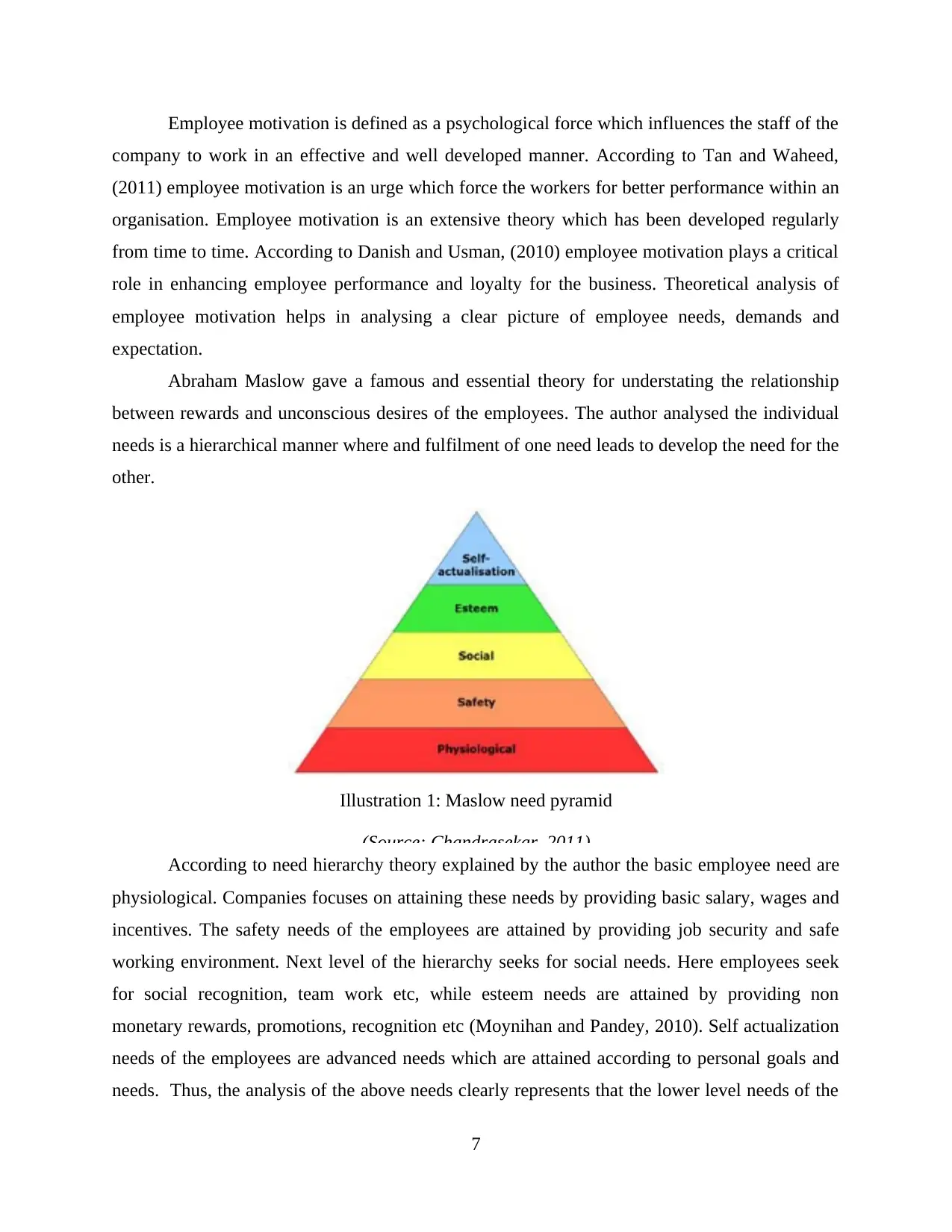
Employee motivation is defined as a psychological force which influences the staff of the
company to work in an effective and well developed manner. According to Tan and Waheed,
(2011) employee motivation is an urge which force the workers for better performance within an
organisation. Employee motivation is an extensive theory which has been developed regularly
from time to time. According to Danish and Usman, (2010) employee motivation plays a critical
role in enhancing employee performance and loyalty for the business. Theoretical analysis of
employee motivation helps in analysing a clear picture of employee needs, demands and
expectation.
Abraham Maslow gave a famous and essential theory for understating the relationship
between rewards and unconscious desires of the employees. The author analysed the individual
needs is a hierarchical manner where and fulfilment of one need leads to develop the need for the
other.
According to need hierarchy theory explained by the author the basic employee need are
physiological. Companies focuses on attaining these needs by providing basic salary, wages and
incentives. The safety needs of the employees are attained by providing job security and safe
working environment. Next level of the hierarchy seeks for social needs. Here employees seek
for social recognition, team work etc, while esteem needs are attained by providing non
monetary rewards, promotions, recognition etc (Moynihan and Pandey, 2010). Self actualization
needs of the employees are advanced needs which are attained according to personal goals and
needs. Thus, the analysis of the above needs clearly represents that the lower level needs of the
7
Illustration 1: Maslow need pyramid
(Source: Chandrasekar, 2011)
company to work in an effective and well developed manner. According to Tan and Waheed,
(2011) employee motivation is an urge which force the workers for better performance within an
organisation. Employee motivation is an extensive theory which has been developed regularly
from time to time. According to Danish and Usman, (2010) employee motivation plays a critical
role in enhancing employee performance and loyalty for the business. Theoretical analysis of
employee motivation helps in analysing a clear picture of employee needs, demands and
expectation.
Abraham Maslow gave a famous and essential theory for understating the relationship
between rewards and unconscious desires of the employees. The author analysed the individual
needs is a hierarchical manner where and fulfilment of one need leads to develop the need for the
other.
According to need hierarchy theory explained by the author the basic employee need are
physiological. Companies focuses on attaining these needs by providing basic salary, wages and
incentives. The safety needs of the employees are attained by providing job security and safe
working environment. Next level of the hierarchy seeks for social needs. Here employees seek
for social recognition, team work etc, while esteem needs are attained by providing non
monetary rewards, promotions, recognition etc (Moynihan and Pandey, 2010). Self actualization
needs of the employees are advanced needs which are attained according to personal goals and
needs. Thus, the analysis of the above needs clearly represents that the lower level needs of the
7
Illustration 1: Maslow need pyramid
(Source: Chandrasekar, 2011)
Paraphrase This Document
Need a fresh take? Get an instant paraphrase of this document with our AI Paraphraser
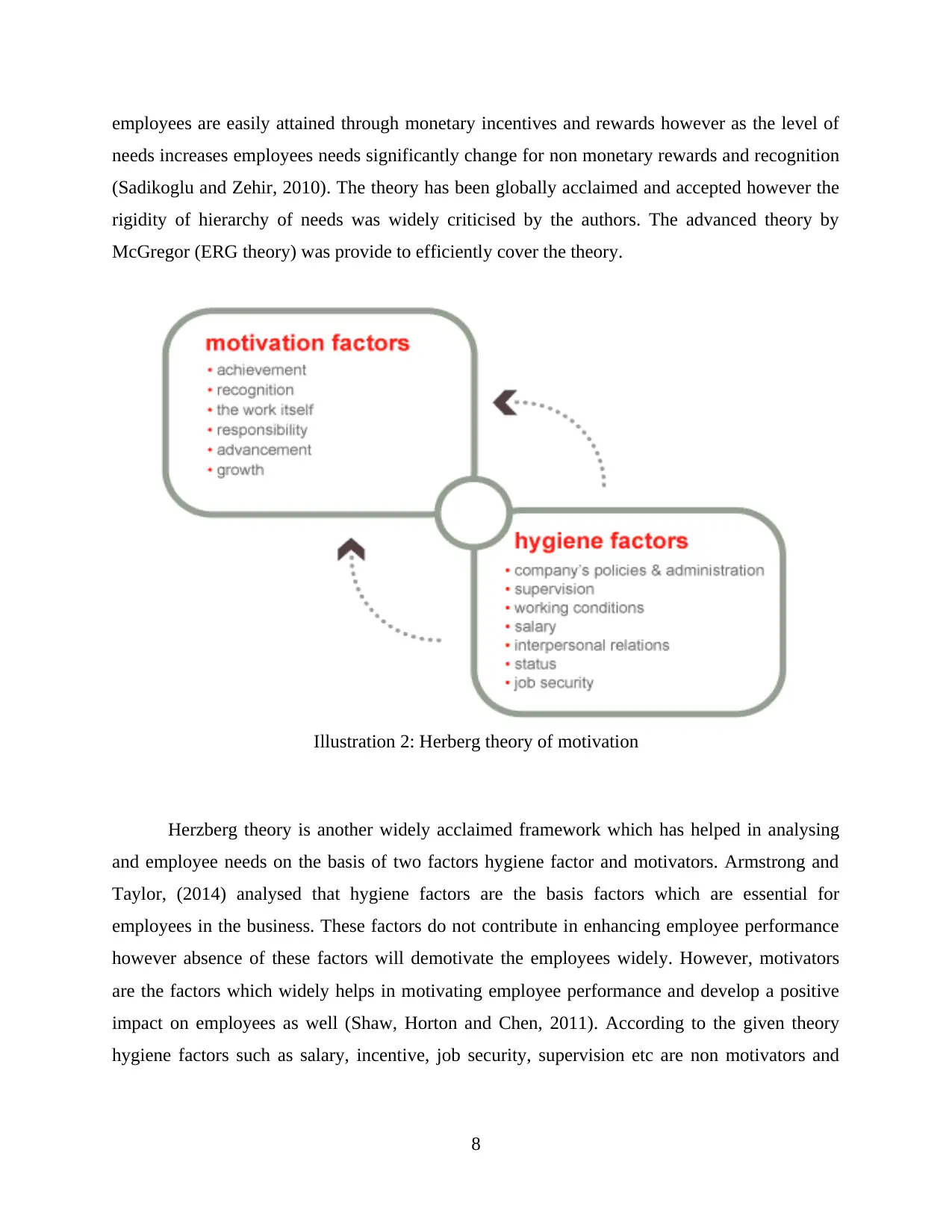
employees are easily attained through monetary incentives and rewards however as the level of
needs increases employees needs significantly change for non monetary rewards and recognition
(Sadikoglu and Zehir, 2010). The theory has been globally acclaimed and accepted however the
rigidity of hierarchy of needs was widely criticised by the authors. The advanced theory by
McGregor (ERG theory) was provide to efficiently cover the theory.
Herzberg theory is another widely acclaimed framework which has helped in analysing
and employee needs on the basis of two factors hygiene factor and motivators. Armstrong and
Taylor, (2014) analysed that hygiene factors are the basis factors which are essential for
employees in the business. These factors do not contribute in enhancing employee performance
however absence of these factors will demotivate the employees widely. However, motivators
are the factors which widely helps in motivating employee performance and develop a positive
impact on employees as well (Shaw, Horton and Chen, 2011). According to the given theory
hygiene factors such as salary, incentive, job security, supervision etc are non motivators and
8
Illustration 2: Herberg theory of motivation
(Source: Doran and et.al., 2011)
needs increases employees needs significantly change for non monetary rewards and recognition
(Sadikoglu and Zehir, 2010). The theory has been globally acclaimed and accepted however the
rigidity of hierarchy of needs was widely criticised by the authors. The advanced theory by
McGregor (ERG theory) was provide to efficiently cover the theory.
Herzberg theory is another widely acclaimed framework which has helped in analysing
and employee needs on the basis of two factors hygiene factor and motivators. Armstrong and
Taylor, (2014) analysed that hygiene factors are the basis factors which are essential for
employees in the business. These factors do not contribute in enhancing employee performance
however absence of these factors will demotivate the employees widely. However, motivators
are the factors which widely helps in motivating employee performance and develop a positive
impact on employees as well (Shaw, Horton and Chen, 2011). According to the given theory
hygiene factors such as salary, incentive, job security, supervision etc are non motivators and
8
Illustration 2: Herberg theory of motivation
(Source: Doran and et.al., 2011)
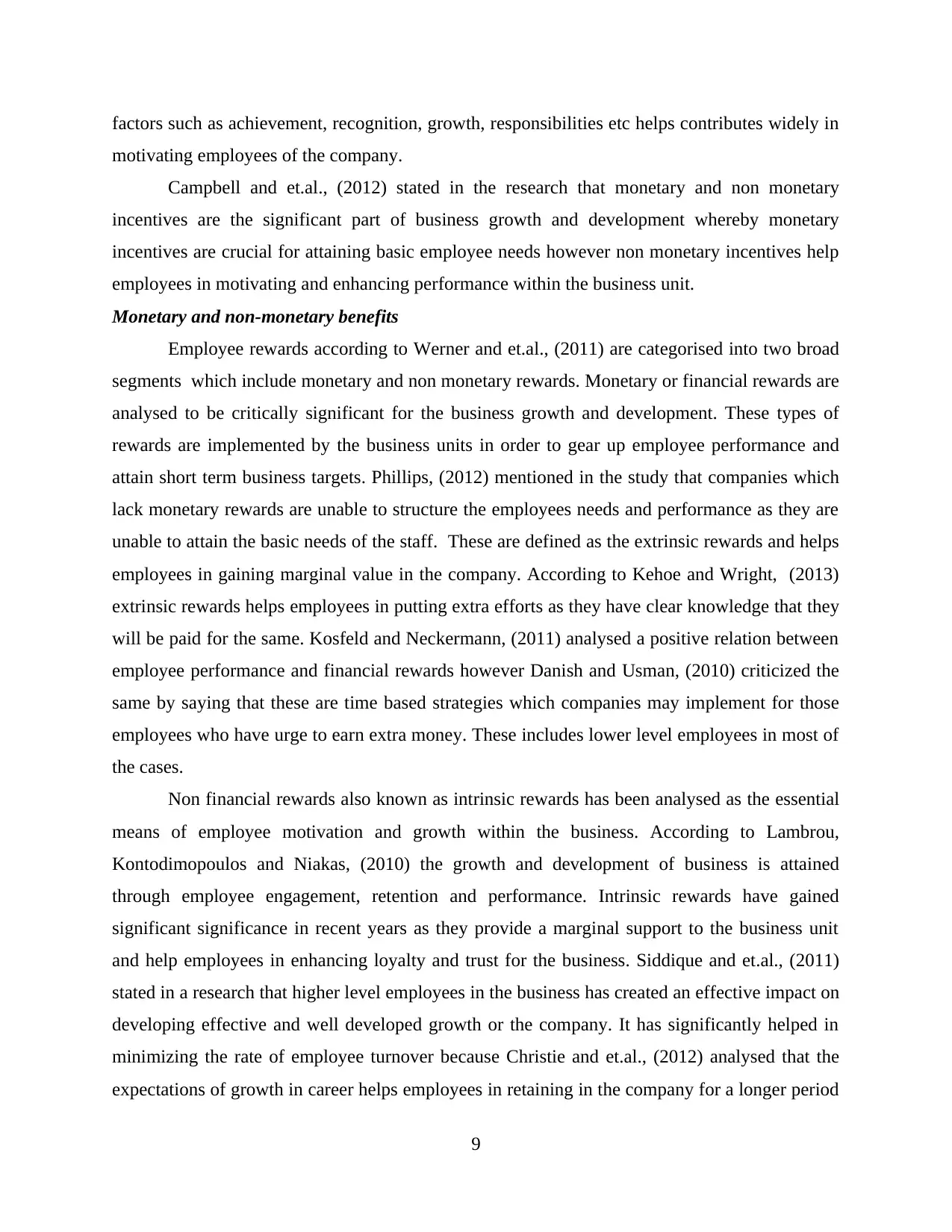
factors such as achievement, recognition, growth, responsibilities etc helps contributes widely in
motivating employees of the company.
Campbell and et.al., (2012) stated in the research that monetary and non monetary
incentives are the significant part of business growth and development whereby monetary
incentives are crucial for attaining basic employee needs however non monetary incentives help
employees in motivating and enhancing performance within the business unit.
Monetary and non-monetary benefits
Employee rewards according to Werner and et.al., (2011) are categorised into two broad
segments which include monetary and non monetary rewards. Monetary or financial rewards are
analysed to be critically significant for the business growth and development. These types of
rewards are implemented by the business units in order to gear up employee performance and
attain short term business targets. Phillips, (2012) mentioned in the study that companies which
lack monetary rewards are unable to structure the employees needs and performance as they are
unable to attain the basic needs of the staff. These are defined as the extrinsic rewards and helps
employees in gaining marginal value in the company. According to Kehoe and Wright, (2013)
extrinsic rewards helps employees in putting extra efforts as they have clear knowledge that they
will be paid for the same. Kosfeld and Neckermann, (2011) analysed a positive relation between
employee performance and financial rewards however Danish and Usman, (2010) criticized the
same by saying that these are time based strategies which companies may implement for those
employees who have urge to earn extra money. These includes lower level employees in most of
the cases.
Non financial rewards also known as intrinsic rewards has been analysed as the essential
means of employee motivation and growth within the business. According to Lambrou,
Kontodimopoulos and Niakas, (2010) the growth and development of business is attained
through employee engagement, retention and performance. Intrinsic rewards have gained
significant significance in recent years as they provide a marginal support to the business unit
and help employees in enhancing loyalty and trust for the business. Siddique and et.al., (2011)
stated in a research that higher level employees in the business has created an effective impact on
developing effective and well developed growth or the company. It has significantly helped in
minimizing the rate of employee turnover because Christie and et.al., (2012) analysed that the
expectations of growth in career helps employees in retaining in the company for a longer period
9
motivating employees of the company.
Campbell and et.al., (2012) stated in the research that monetary and non monetary
incentives are the significant part of business growth and development whereby monetary
incentives are crucial for attaining basic employee needs however non monetary incentives help
employees in motivating and enhancing performance within the business unit.
Monetary and non-monetary benefits
Employee rewards according to Werner and et.al., (2011) are categorised into two broad
segments which include monetary and non monetary rewards. Monetary or financial rewards are
analysed to be critically significant for the business growth and development. These types of
rewards are implemented by the business units in order to gear up employee performance and
attain short term business targets. Phillips, (2012) mentioned in the study that companies which
lack monetary rewards are unable to structure the employees needs and performance as they are
unable to attain the basic needs of the staff. These are defined as the extrinsic rewards and helps
employees in gaining marginal value in the company. According to Kehoe and Wright, (2013)
extrinsic rewards helps employees in putting extra efforts as they have clear knowledge that they
will be paid for the same. Kosfeld and Neckermann, (2011) analysed a positive relation between
employee performance and financial rewards however Danish and Usman, (2010) criticized the
same by saying that these are time based strategies which companies may implement for those
employees who have urge to earn extra money. These includes lower level employees in most of
the cases.
Non financial rewards also known as intrinsic rewards has been analysed as the essential
means of employee motivation and growth within the business. According to Lambrou,
Kontodimopoulos and Niakas, (2010) the growth and development of business is attained
through employee engagement, retention and performance. Intrinsic rewards have gained
significant significance in recent years as they provide a marginal support to the business unit
and help employees in enhancing loyalty and trust for the business. Siddique and et.al., (2011)
stated in a research that higher level employees in the business has created an effective impact on
developing effective and well developed growth or the company. It has significantly helped in
minimizing the rate of employee turnover because Christie and et.al., (2012) analysed that the
expectations of growth in career helps employees in retaining in the company for a longer period
9
⊘ This is a preview!⊘
Do you want full access?
Subscribe today to unlock all pages.

Trusted by 1+ million students worldwide
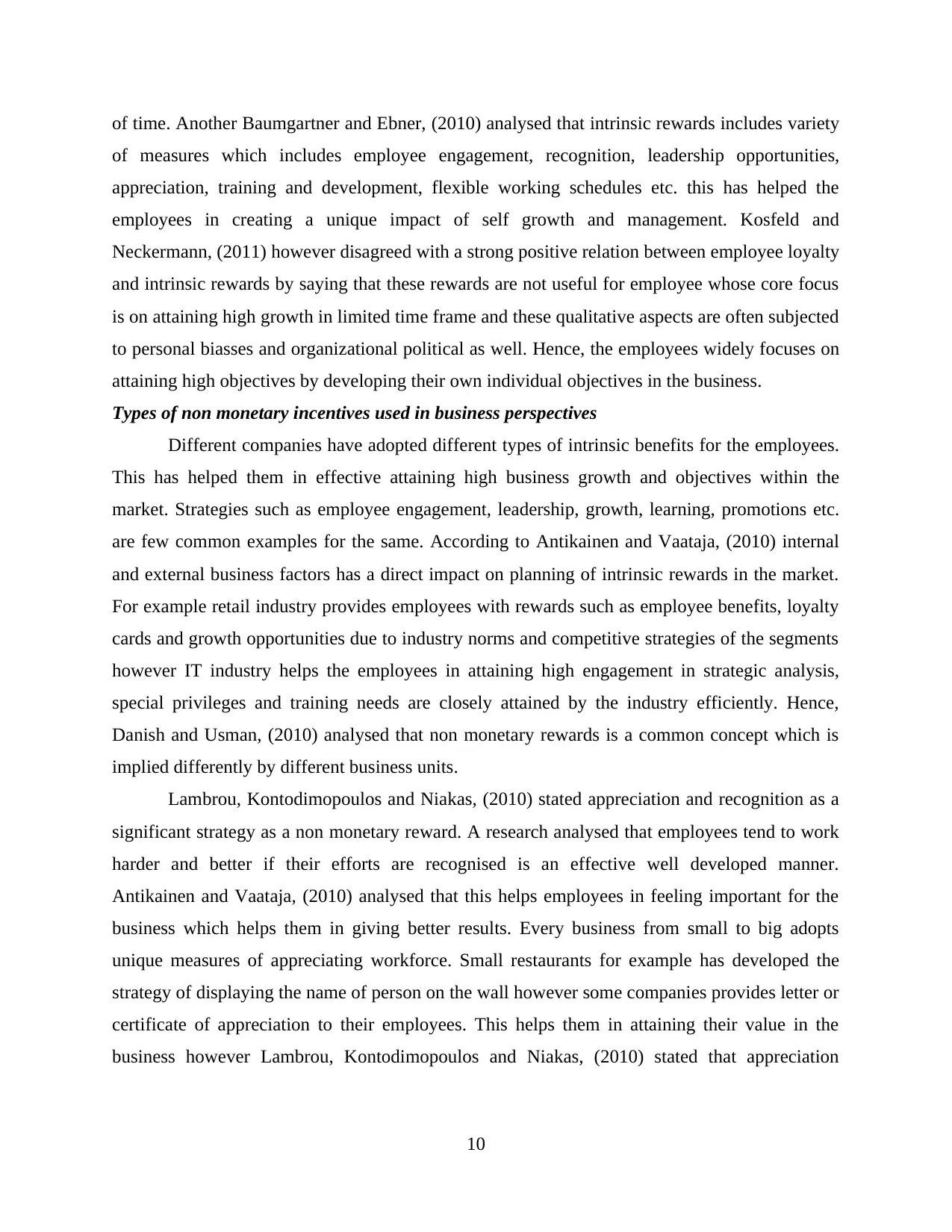
of time. Another Baumgartner and Ebner, (2010) analysed that intrinsic rewards includes variety
of measures which includes employee engagement, recognition, leadership opportunities,
appreciation, training and development, flexible working schedules etc. this has helped the
employees in creating a unique impact of self growth and management. Kosfeld and
Neckermann, (2011) however disagreed with a strong positive relation between employee loyalty
and intrinsic rewards by saying that these rewards are not useful for employee whose core focus
is on attaining high growth in limited time frame and these qualitative aspects are often subjected
to personal biasses and organizational political as well. Hence, the employees widely focuses on
attaining high objectives by developing their own individual objectives in the business.
Types of non monetary incentives used in business perspectives
Different companies have adopted different types of intrinsic benefits for the employees.
This has helped them in effective attaining high business growth and objectives within the
market. Strategies such as employee engagement, leadership, growth, learning, promotions etc.
are few common examples for the same. According to Antikainen and Vaataja, (2010) internal
and external business factors has a direct impact on planning of intrinsic rewards in the market.
For example retail industry provides employees with rewards such as employee benefits, loyalty
cards and growth opportunities due to industry norms and competitive strategies of the segments
however IT industry helps the employees in attaining high engagement in strategic analysis,
special privileges and training needs are closely attained by the industry efficiently. Hence,
Danish and Usman, (2010) analysed that non monetary rewards is a common concept which is
implied differently by different business units.
Lambrou, Kontodimopoulos and Niakas, (2010) stated appreciation and recognition as a
significant strategy as a non monetary reward. A research analysed that employees tend to work
harder and better if their efforts are recognised is an effective well developed manner.
Antikainen and Vaataja, (2010) analysed that this helps employees in feeling important for the
business which helps them in giving better results. Every business from small to big adopts
unique measures of appreciating workforce. Small restaurants for example has developed the
strategy of displaying the name of person on the wall however some companies provides letter or
certificate of appreciation to their employees. This helps them in attaining their value in the
business however Lambrou, Kontodimopoulos and Niakas, (2010) stated that appreciation
10
of measures which includes employee engagement, recognition, leadership opportunities,
appreciation, training and development, flexible working schedules etc. this has helped the
employees in creating a unique impact of self growth and management. Kosfeld and
Neckermann, (2011) however disagreed with a strong positive relation between employee loyalty
and intrinsic rewards by saying that these rewards are not useful for employee whose core focus
is on attaining high growth in limited time frame and these qualitative aspects are often subjected
to personal biasses and organizational political as well. Hence, the employees widely focuses on
attaining high objectives by developing their own individual objectives in the business.
Types of non monetary incentives used in business perspectives
Different companies have adopted different types of intrinsic benefits for the employees.
This has helped them in effective attaining high business growth and objectives within the
market. Strategies such as employee engagement, leadership, growth, learning, promotions etc.
are few common examples for the same. According to Antikainen and Vaataja, (2010) internal
and external business factors has a direct impact on planning of intrinsic rewards in the market.
For example retail industry provides employees with rewards such as employee benefits, loyalty
cards and growth opportunities due to industry norms and competitive strategies of the segments
however IT industry helps the employees in attaining high engagement in strategic analysis,
special privileges and training needs are closely attained by the industry efficiently. Hence,
Danish and Usman, (2010) analysed that non monetary rewards is a common concept which is
implied differently by different business units.
Lambrou, Kontodimopoulos and Niakas, (2010) stated appreciation and recognition as a
significant strategy as a non monetary reward. A research analysed that employees tend to work
harder and better if their efforts are recognised is an effective well developed manner.
Antikainen and Vaataja, (2010) analysed that this helps employees in feeling important for the
business which helps them in giving better results. Every business from small to big adopts
unique measures of appreciating workforce. Small restaurants for example has developed the
strategy of displaying the name of person on the wall however some companies provides letter or
certificate of appreciation to their employees. This helps them in attaining their value in the
business however Lambrou, Kontodimopoulos and Niakas, (2010) stated that appreciation
10
Paraphrase This Document
Need a fresh take? Get an instant paraphrase of this document with our AI Paraphraser
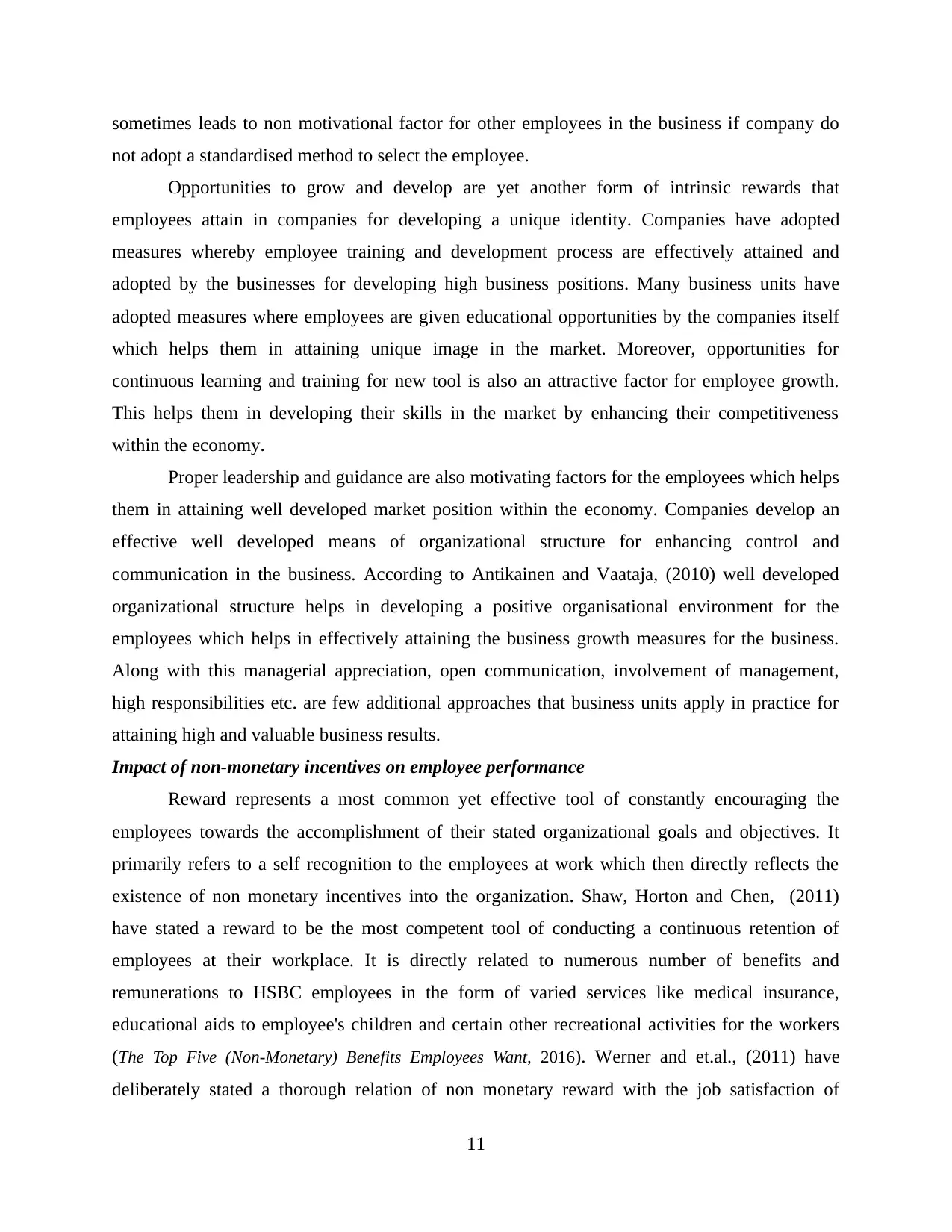
sometimes leads to non motivational factor for other employees in the business if company do
not adopt a standardised method to select the employee.
Opportunities to grow and develop are yet another form of intrinsic rewards that
employees attain in companies for developing a unique identity. Companies have adopted
measures whereby employee training and development process are effectively attained and
adopted by the businesses for developing high business positions. Many business units have
adopted measures where employees are given educational opportunities by the companies itself
which helps them in attaining unique image in the market. Moreover, opportunities for
continuous learning and training for new tool is also an attractive factor for employee growth.
This helps them in developing their skills in the market by enhancing their competitiveness
within the economy.
Proper leadership and guidance are also motivating factors for the employees which helps
them in attaining well developed market position within the economy. Companies develop an
effective well developed means of organizational structure for enhancing control and
communication in the business. According to Antikainen and Vaataja, (2010) well developed
organizational structure helps in developing a positive organisational environment for the
employees which helps in effectively attaining the business growth measures for the business.
Along with this managerial appreciation, open communication, involvement of management,
high responsibilities etc. are few additional approaches that business units apply in practice for
attaining high and valuable business results.
Impact of non-monetary incentives on employee performance
Reward represents a most common yet effective tool of constantly encouraging the
employees towards the accomplishment of their stated organizational goals and objectives. It
primarily refers to a self recognition to the employees at work which then directly reflects the
existence of non monetary incentives into the organization. Shaw, Horton and Chen, (2011)
have stated a reward to be the most competent tool of conducting a continuous retention of
employees at their workplace. It is directly related to numerous number of benefits and
remunerations to HSBC employees in the form of varied services like medical insurance,
educational aids to employee's children and certain other recreational activities for the workers
(The Top Five (Non-Monetary) Benefits Employees Want, 2016). Werner and et.al., (2011) have
deliberately stated a thorough relation of non monetary reward with the job satisfaction of
11
not adopt a standardised method to select the employee.
Opportunities to grow and develop are yet another form of intrinsic rewards that
employees attain in companies for developing a unique identity. Companies have adopted
measures whereby employee training and development process are effectively attained and
adopted by the businesses for developing high business positions. Many business units have
adopted measures where employees are given educational opportunities by the companies itself
which helps them in attaining unique image in the market. Moreover, opportunities for
continuous learning and training for new tool is also an attractive factor for employee growth.
This helps them in developing their skills in the market by enhancing their competitiveness
within the economy.
Proper leadership and guidance are also motivating factors for the employees which helps
them in attaining well developed market position within the economy. Companies develop an
effective well developed means of organizational structure for enhancing control and
communication in the business. According to Antikainen and Vaataja, (2010) well developed
organizational structure helps in developing a positive organisational environment for the
employees which helps in effectively attaining the business growth measures for the business.
Along with this managerial appreciation, open communication, involvement of management,
high responsibilities etc. are few additional approaches that business units apply in practice for
attaining high and valuable business results.
Impact of non-monetary incentives on employee performance
Reward represents a most common yet effective tool of constantly encouraging the
employees towards the accomplishment of their stated organizational goals and objectives. It
primarily refers to a self recognition to the employees at work which then directly reflects the
existence of non monetary incentives into the organization. Shaw, Horton and Chen, (2011)
have stated a reward to be the most competent tool of conducting a continuous retention of
employees at their workplace. It is directly related to numerous number of benefits and
remunerations to HSBC employees in the form of varied services like medical insurance,
educational aids to employee's children and certain other recreational activities for the workers
(The Top Five (Non-Monetary) Benefits Employees Want, 2016). Werner and et.al., (2011) have
deliberately stated a thorough relation of non monetary reward with the job satisfaction of
11
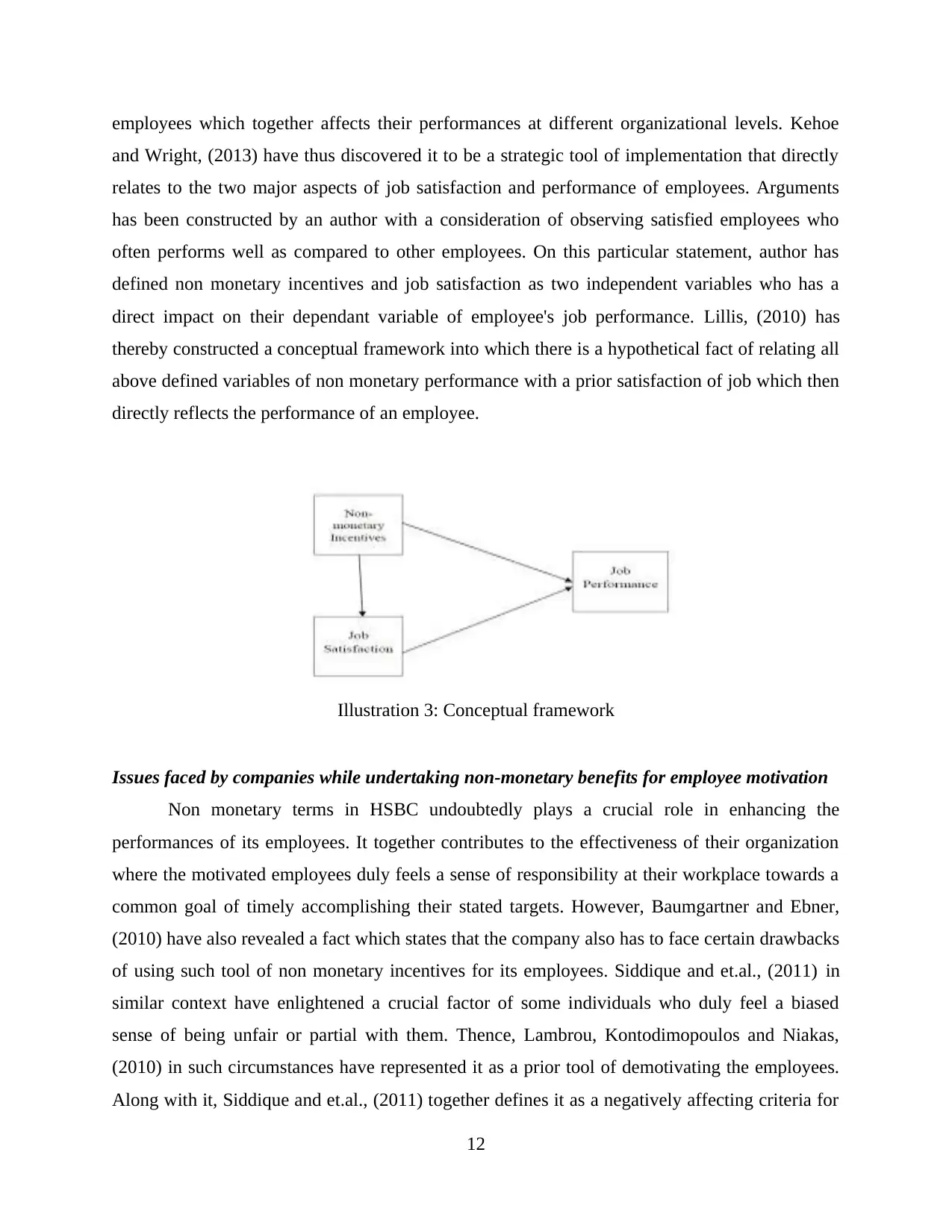
employees which together affects their performances at different organizational levels. Kehoe
and Wright, (2013) have thus discovered it to be a strategic tool of implementation that directly
relates to the two major aspects of job satisfaction and performance of employees. Arguments
has been constructed by an author with a consideration of observing satisfied employees who
often performs well as compared to other employees. On this particular statement, author has
defined non monetary incentives and job satisfaction as two independent variables who has a
direct impact on their dependant variable of employee's job performance. Lillis, (2010) has
thereby constructed a conceptual framework into which there is a hypothetical fact of relating all
above defined variables of non monetary performance with a prior satisfaction of job which then
directly reflects the performance of an employee.
Issues faced by companies while undertaking non-monetary benefits for employee motivation
Non monetary terms in HSBC undoubtedly plays a crucial role in enhancing the
performances of its employees. It together contributes to the effectiveness of their organization
where the motivated employees duly feels a sense of responsibility at their workplace towards a
common goal of timely accomplishing their stated targets. However, Baumgartner and Ebner,
(2010) have also revealed a fact which states that the company also has to face certain drawbacks
of using such tool of non monetary incentives for its employees. Siddique and et.al., (2011) in
similar context have enlightened a crucial factor of some individuals who duly feel a biased
sense of being unfair or partial with them. Thence, Lambrou, Kontodimopoulos and Niakas,
(2010) in such circumstances have represented it as a prior tool of demotivating the employees.
Along with it, Siddique and et.al., (2011) together defines it as a negatively affecting criteria for
12
Illustration 3: Conceptual framework
and Wright, (2013) have thus discovered it to be a strategic tool of implementation that directly
relates to the two major aspects of job satisfaction and performance of employees. Arguments
has been constructed by an author with a consideration of observing satisfied employees who
often performs well as compared to other employees. On this particular statement, author has
defined non monetary incentives and job satisfaction as two independent variables who has a
direct impact on their dependant variable of employee's job performance. Lillis, (2010) has
thereby constructed a conceptual framework into which there is a hypothetical fact of relating all
above defined variables of non monetary performance with a prior satisfaction of job which then
directly reflects the performance of an employee.
Issues faced by companies while undertaking non-monetary benefits for employee motivation
Non monetary terms in HSBC undoubtedly plays a crucial role in enhancing the
performances of its employees. It together contributes to the effectiveness of their organization
where the motivated employees duly feels a sense of responsibility at their workplace towards a
common goal of timely accomplishing their stated targets. However, Baumgartner and Ebner,
(2010) have also revealed a fact which states that the company also has to face certain drawbacks
of using such tool of non monetary incentives for its employees. Siddique and et.al., (2011) in
similar context have enlightened a crucial factor of some individuals who duly feel a biased
sense of being unfair or partial with them. Thence, Lambrou, Kontodimopoulos and Niakas,
(2010) in such circumstances have represented it as a prior tool of demotivating the employees.
Along with it, Siddique and et.al., (2011) together defines it as a negatively affecting criteria for
12
Illustration 3: Conceptual framework
⊘ This is a preview!⊘
Do you want full access?
Subscribe today to unlock all pages.

Trusted by 1+ million students worldwide
1 out of 19
Related Documents
Your All-in-One AI-Powered Toolkit for Academic Success.
+13062052269
info@desklib.com
Available 24*7 on WhatsApp / Email
![[object Object]](/_next/static/media/star-bottom.7253800d.svg)
Unlock your academic potential
Copyright © 2020–2025 A2Z Services. All Rights Reserved. Developed and managed by ZUCOL.





